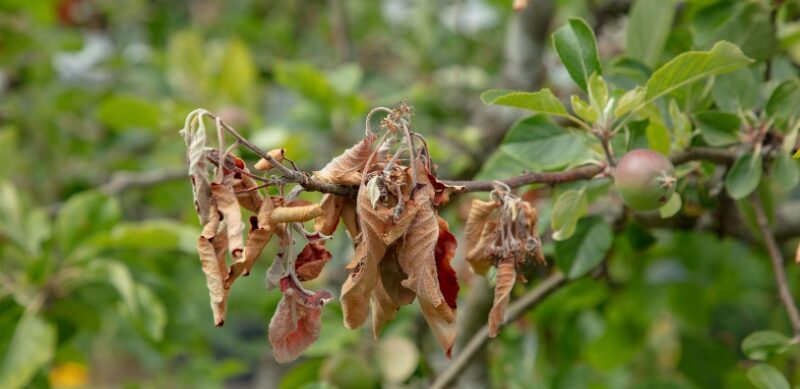What Is Fire Blight?

If you’re a gardener or orchard owner in California, you may have heard of fire blight, a destructive bacterial disease that affects fruit trees. Fire blight can spread rapidly, causing serious damage to apple, pear, and other fruit-bearing trees. Understanding what fire blight is, how it spreads, and what you can do to protect your trees is crucial for maintaining a healthy garden or orchard.
What Causes Fire Blight?
Fire blight is caused by the bacterium Erwinia amylovora, which primarily affects members of the rose family, including apples, pears, and crabapples. The disease is named for the scorched, blackened appearance it gives to infected trees, as if they’ve been burned by fire.
The bacteria are most active during warm, wet weather, making spring and early summer the peak seasons for fire blight outbreaks. However, fire blight can also overwinter in infected trees, allowing it to spread the following year if not properly managed.
Symptoms of Fire Blight
Fire blight can affect several parts of a tree, including blossoms, leaves, shoots, and fruit. Common symptoms include:
- Blackened Blossoms: Infected flowers turn brown or black and wilt. The infection often starts at the blossoms and spreads to the rest of the tree.
- Shepherd’s Crook: As fire blight progresses, the ends of infected branches may curl into a distinctive “shepherd’s crook” shape.
- Oozing Cankers: The bacteria create sunken, discolored areas (cankers) on the tree’s branches and trunk. These cankers may ooze a sticky, amber-colored liquid, which contains the bacteria and can spread the infection.
- Scorched Leaves: Leaves on infected branches may turn brown or black, appearing as though they’ve been scorched by fire. These leaves often remain attached to the tree long after they’ve died.
How Fire Blight Spreads
Fire blight spreads through rain, wind, insects, and even contaminated pruning tools. The bacteria can enter a tree through natural openings, such as blossoms or wounds caused by pruning, insects, or hail. Once inside, the bacteria move through the tree’s vascular system, causing widespread damage.
In addition to spreading from tree to tree, fire blight can also infect entire orchards if left unchecked, making it a serious threat to fruit production.
How to Prevent Fire Blight
Preventing fire blight requires a combination of good cultural practices and early intervention. Here are some steps you can take to protect your trees:
1. Choose Resistant Varieties
Some apple and pear tree varieties are more resistant to fire blight than others. If you’re planting new trees, consider choosing fire blight-resistant cultivars.
2. Prune Infected Branches
If you notice signs of fire blight on your trees, prune the infected branches immediately to prevent the disease from spreading. Cut at least 8-12 inches below the visible signs of infection, and disinfect your pruning tools between each cut.
3. Avoid Over-Fertilization
Excessive nitrogen can encourage new, tender growth that is more susceptible to fire blight. Fertilize your trees carefully, following recommended guidelines for your tree species.
4. Monitor for Symptoms
Regularly inspect your trees, especially during the spring when the disease is most likely to spread. Early detection is key to controlling fire blight before it spreads too far.
Why Professional Help May Be Necessary
If fire blight is already present in your orchard or garden, professional treatment may be necessary to stop the spread and save your trees. Arborists or garden experts can provide targeted treatments, including pruning and the application of appropriate bactericides.
By staying vigilant and taking proactive measures, you can help protect your fruit trees from the devastating effects of fire blight. Reach out to The Experienced Gardener for help protecting your trees from fire blight.


